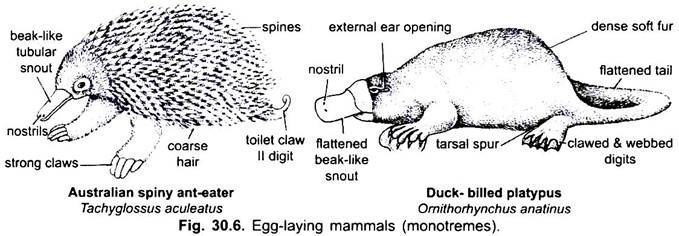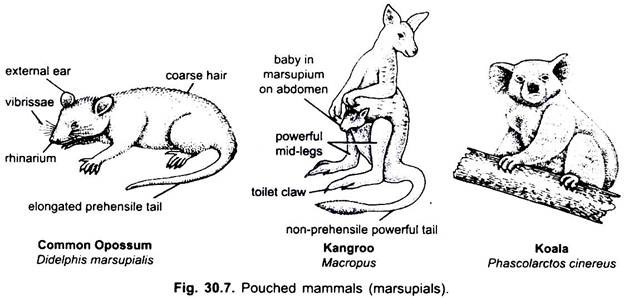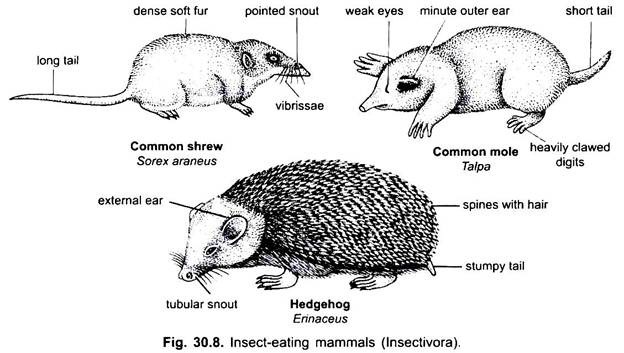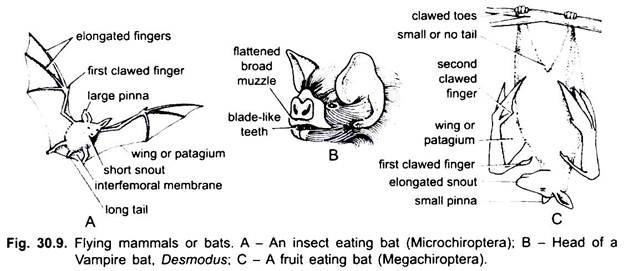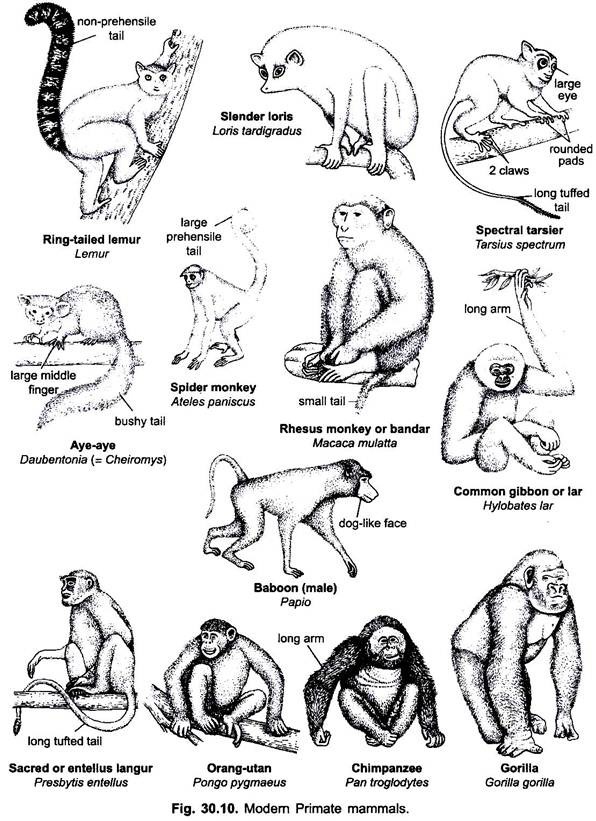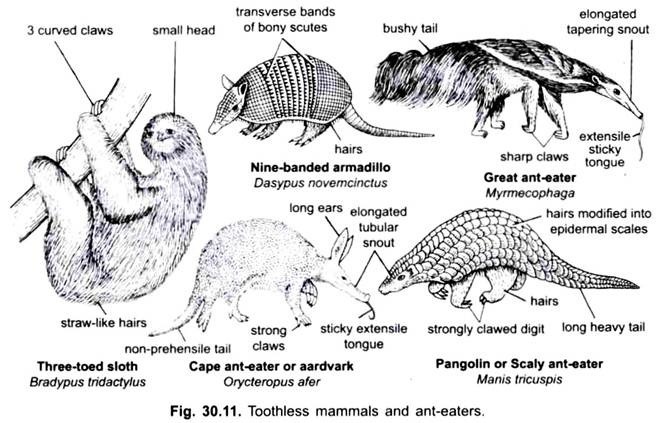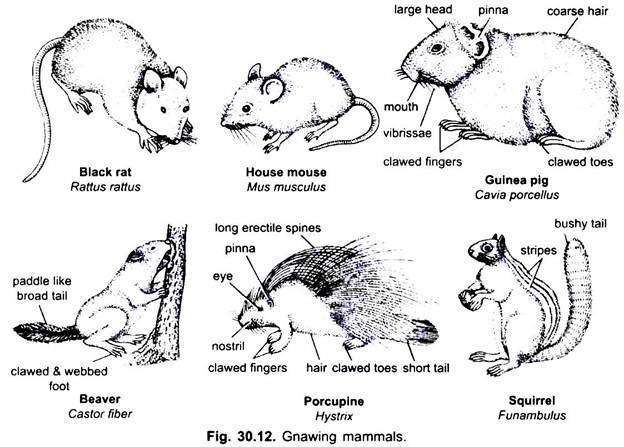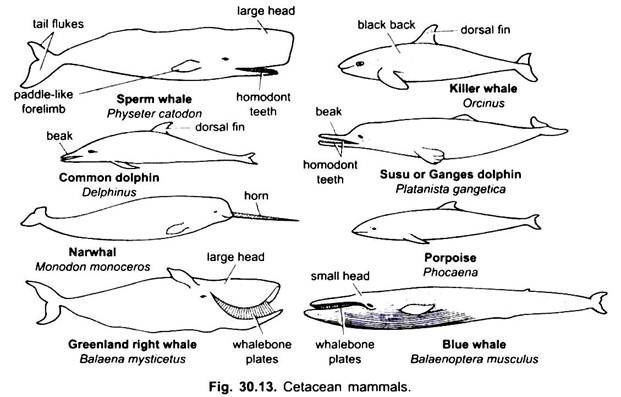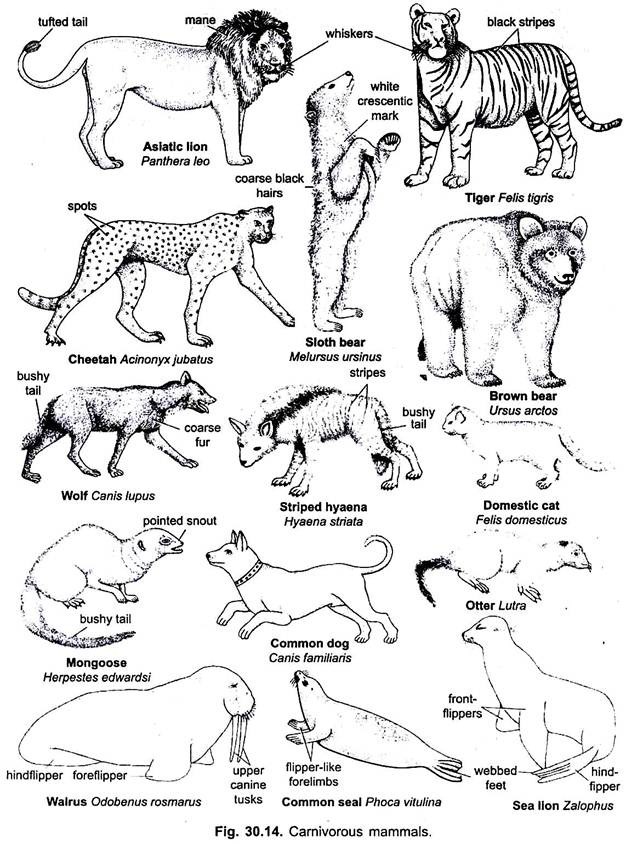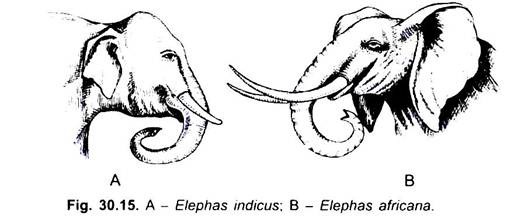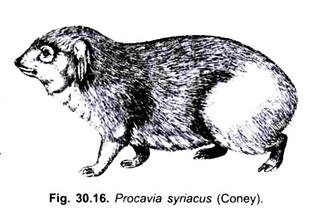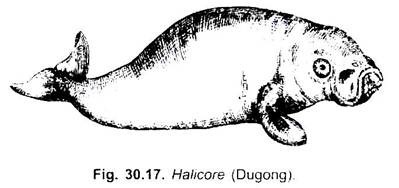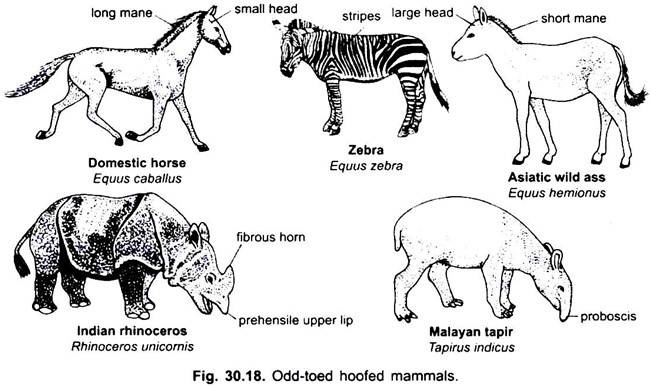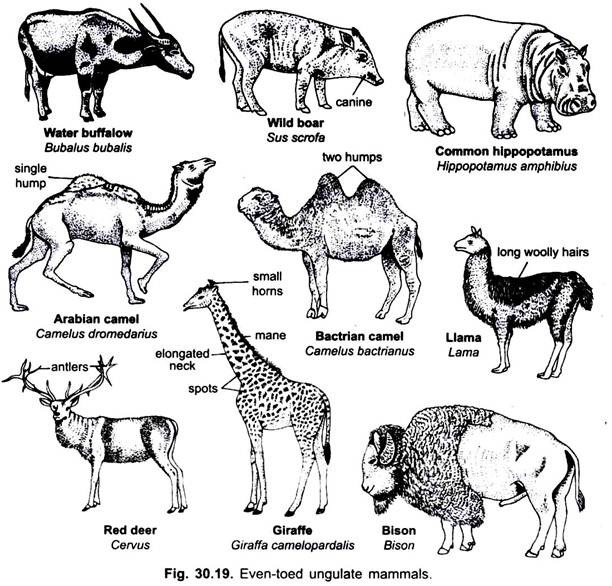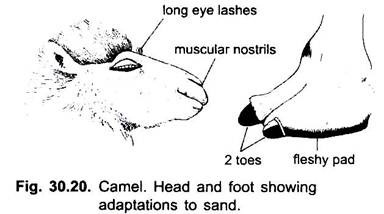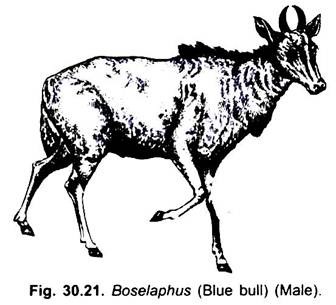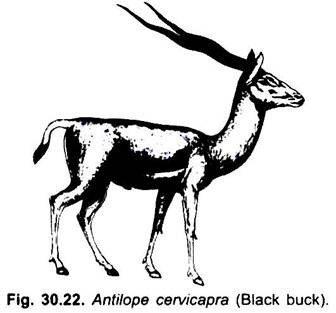Here is a compilation of essays on ‘Mammals’ for class 11 and 12. Find paragraphs, long and short essays on ‘Mammals’ especially written for school and college students.
Essay on Mammals
Essay Contents:
- Essay on Monotremes or Egg-Laying Mammals
- Essay on Marsupials or Pouched Mammals
- Essay on Insectivorous Mammals (Insectivora)
- Essay on Flying Mammals
- Essay on Primates
- Essay on Toothless Mammals
- Essay on Other Ant-Eaters
- Essay on Gnawing Mammals
- Essay on Cetacean Mammals
- Essay on Carnivorous Mammals
- Essay on Proboscidean Mammal
- Essay on Hyracoidean Mammal
- Essay on Sirenian Mammal
- Essay on Ungulates (Hoofed Mammals)
1. Essay on Monotremes or Egg-Laying Mammals:
ADVERTISEMENTS:
1. Tachyglossus:
Tachyglossus aculeatus also called Echidna (Fig. 30.6) is a spiny anteater found in Australia and Tasmania. Another genus, Zaglossus (Proechidna), is found in New Guinea. The body is covered above with strong pointed spines and coarse hairs, ventral side has no spines but only hairs. The animal can roll into a ball for protection. It is terrestrial and burrowing though it does not make tunnels. It is nocturnal and specialised for ant-eating.
The jaws form a long, tubular snout or rostrum which is tactile and has a terminal rounded mouth. There are no teeth at any stage. There is a long sticky, protrusible tongue, used for capturing ants and insects. The dorsal surface of the tongue has horny serrations which grind the insects against ridges of the palate.
ADVERTISEMENTS:
The saliva neutralises the formic acid of ants. Eyes are small with no nictitating membrane; they are reptilian with little accommodation. Ears have inconspicuous pinna. The tail is vestigial. The girdles and limbs are reptilian. The limbs are held laterally, and have five digits with sharp claws used for burrowing and tearing up ant-hills.
In the hindlimbs the second digit has a long, curved toilet-claw to clean the spines and hair. In the male there is a grooved horny poison-spur on the tarsus and a poison gland in the thigh from which poison passes into the spur. Cervical vertebrae bear separate ribs, in all there are 16 ribs.
There are no sweat glands. Penis is a simple groove on the floor of the cloaca, it is used only for the passage of sperms, urine passes through a special urinary canal. The female lays one or two leathery eggs in a nest, then it places them in a pouch of skin on the abdomen, which develops during breeding season.
This pouch is supported by two epipubic bones arising from the pelvic girdle. The young hatches in the pouch in an immature condition and is nourished on milk from mammary glands which are modified sweat glands and have no nipples.
ADVERTISEMENTS:
The young suck milk from moistened hair. The youngs are carried in the pouch till they are 7.5 to 10 cm long. The male also has mammary glands and secretes milk, this condition is known as gynaecomastism in which both parents share in feeding the young. It is also found in Platypus.
2. Zaglossus or Proechidna:
It is confined to New Guinea. It is larger in size than Echidna. Body is covered over by short spines concealed by long fur. Head is larger and beak is twice longer than the head. Limbs are three-toed with claws.
3. Ornithorhynchus:
Ornithorhynchus anatinus (Platypus or duck-mole) (Fig. 30.6) differs widely from Tachyglossus in external appearance, but in a few minor details only, the two resemble closely in anatomical structure. Platypus lives in long burrows on river banks in Australia and Tasmania. It is about 20 inches (50-60 cm) long. The flat body is covered with soft brown waterproof under fur and harsher outer fur.
Platypus can roll up into a ball. Upper jaw forms a broad, flat muzzle like the bill of a duck. It is covered with soft hairless skin and has pitted tactile organs. The muzzle is moist and flexible having dorsal nostrils, used for capturing worms and molluscs from mud of river beds which can be stored in cheek pouches. Teeth are found in the young but are replaced in the adult by horny epidermal plates used for breaking shells of molluscs, sand taken in with food assists in mastication.
Eyes are small and have nictitating membranes, ears have no pinnae. When under water, the eyes and ears are covered by skin pouches and the animal fends by touch and smell. There is a broad flat 5 inches (12.5 cm) long tail, used for swimming. Front limbs are short and powerful having five digits with strong claws for digging. Lying below and projecting beyond the claws is a web having leathery extensions; the web is used for swimming, when walking or digging the web can be folded back.
Hindlimbs have five digits with sharp claws and also webbed. The proximal end of the fibula projects backwards like the olecranon process of ulna. In male there is a horny sharp, stout, movable hollow tarsal spur on the inner side of the tarsus, a duct from a poison gland in the thigh opens into the spur. This is more developed than in Tachyglossus. Testes are internal, the penis is a simple groove in the cloaca.
Platypus goes into rivers only in the morning and evening in search of food. After copulation the female lays two small membranous shelled eggs in a nest at the end of a long burrow which is blocked with mud at several places by the female. They are 6 mm in diameter and often superficially conjoined.
ADVERTISEMENTS:
After 14 days of incubation the young ones hatch, they are naked, blind and about 2-5 cm long. The female holds the young to the abdomen with her tail, and are fed on milk from sudorific mammary glands which open on flat patches of skin. There are no nipples. The male probably also secretes milk.
2. Essay on Marsupials or Pouched Mammals:
1. Macropus:
Macropus (kangaroo) (Fig. 30.7) is found in Australia, Tasmania and New Guinea on grassy plains. It has about 25 species. Macropus is the largest kangaroo. It is herbivorous and terrestrial and causes much damage to crops. It is up to 6 feet (1.80 metre) standing. The front part of the body including small head, neck, and small forelimbs and hind part of the body, legs, and tail are large.
The small head has a small flat brain case, teeth are numerous with a dental formula 3, 1, 2, 4/1, 0, 2, 4 = 34. The small forelimbs have five clawed digits and are not used in locomotion. They are used as hands and to support the body while feeding.
Hindlimbs are long and powerful, the foot has four digits, the hallux being absent, second and third metatarsals and digits are thin and small, these two digits are united together by integument so that the foot appears three-toed. The fourth metatarsal and digit are very large with a strong claw which is used in fighting, the fifth toe is small.
The tail is long, round and thick, it serves as third leg in locomotion and at rest. Locomotion is bipedal with modifications in ilia and thigh muscles. The kangaroo moves rapidly by long erect springs of over 25 feet by jumping. The tail is used for balancing.
The young develop in the uterus with a yolk sac placenta. They are born immature and naked, grub-like, about one inch (2.5 cm) long and are transferred into a large marsupium of the mother supported by epipubic or marsupial bones of the pelvic girdle. In the marsupium the young are fed on milk from true mammary glands having nipples. The young venture out when they are four to six months old. Kangaroos are terrestrial, gregarious and herbivorous, and cause damage to standing crops. They are hunted for meat, fur and sport.
2. Didelphis:
Didelphis (Opossum) (Fig. 30.7) is found in Australia and North and South America. It is a small, arboreal, nocturnal and insectivorous marsupial. Didelphis marsupialis is the common opossum found in Eastern U.S.A. to South America. It is about 50 cm long and its body is covered over by a coarse fur. It has a long prehensile tail. Its legs are smaller, snout is elongated and eyes are large and black over its white face. It has a long scaly prehensile tail.
3. Phascolarctos (Koala):
Phascolarctos (Fig. 30.7) is arboreal and feeds upon eucalyptus forests of Eastern Australia. It is about 75 cm long. Its body is covered over by woolly fur and has large ears, a soft pad on nose, and rudimentary tail. Female carries its young in a posteriorly opening abdominal pouch.
First digit on both limbs is oppsable, used for grasping the objects. Incisor 10/8 in the upper and lower jaws respectively. It is arboreal, nocturnal and omnivorous. Gestation period is 12 to 14 days. Female give birth to 7-13 youngs, each about 1 cm long.
3. Essay on Insectivorous Mammals (Insectivora):
1. Sorex:
Sorex (shrew) (Fig. 30.8) is rat-like. It is 3 inches (7.50 cm) long excluding the tail. The tail is about 2 inches. It is reddish-brown and pale. Snout is elongated and body is covered with silky far. Eyes and ears are small. First pair of incisors is very long, lower canines are absent, all teeth are red, the dentition is 3, 1, 3, 3/2, 0, 1, 3 = 32. Limbs short and have five clawed digits.
It lives in tunnels (burrows) and comes out in the night and feeds on insects, worms, and mice. Shrews have a higher rate of metabolism than other mammals. They cannot live without food for more than 10 hours. Because of their great expenditure of energy, shrews daily consume twice as much food as their weight.
They are untamable, hence the name. Cats do not eat shrews because of their rancid odour. Shrews are found in Asia, Europe, and North America. The Indian shrew belongs to genus Soriculus, commonly called “chhuchhunder.”
2. Crocidura:
Crocidura (musk-shrew) is like a rat in body. The colour is light gray and the fur is silky. It has a pointed snout, eyes are small, dentition is complete, pinnae are small and depressed. Tail is comparatively short. The snout, pinnae, feet and tail are pinkish in colour with scanty hair.
It is characterised by a strong obnoxious odour due to secretion of a pair of musk glands behind the arm pits. Their secretion is stronger during the breeding season. Musk glands are absent in females of some species. It is insectivorous and comes into houses at night in search of insects. It is found in Asia, Africa, Europe and N. America.
3. Erinaceus:
Erinaceus (Fig. 30.8) is commonly known as hedgehog. Their body is small and globular with pointed snout, small stumpy tail and short legs. Eyes are small and black and pinnae are short. On the dorsal side hairs are modified to form sharp, outwardly projecting spines, including hairs and the ventral side has soft far.
A band of muscles passes along the sides and over the neck and base of the tail forming a sphincter for moving the spiny area. The animal rolls up into a ball when in danger and the spines project outward causing harm to the attacking animal. It is nocturnal and feeds on insects, slugs, fruits, birds and snakes. It is immune to snake bite. The hedgehog hibernates in winter. It is found in Asia, Africa, and Europe.
4. Talpa:
Talpa (Fig. 30.8) is commonly known as short-tailed mole and is also called “chhuchhunder.” Moles are related to shrews but are larger in size and have enormous shoulder girdle and muscles. They are profoundly specialised for a subterranean burrowing life. Body is thick, cylindrical and about 6 inches (15 cm) long. The head is wedge-shaped with a prenasal bone in the snout, eyes are rudimentary, and pinnae are minute.
Tail is short with no hair, and is sensory. It has a thick velvety fur. Forelimbs are strong, manus is large and broad, five digits have long, broad nails, and there is an extra sickle-shaped bone of the carpus called radial sesamoid or falciform bone. The hand is used for digging. The mole lives underground digging long tunnels rapidly. It almost never comes to the surface and has a remarkable sense of touch. It feeds on earthworms. It is found in Asia and Europe, the golden mole is African.
4. Essay on Flying Mammals:
1. Pteropus or Cynopterus (Frugivorous Bats):
Pteropus (Fig. 30.9) is commonly known as flying fox due to fox-like head with long snout and large eyes. They belong to the suborder Megachiroptera. It is a large bat with a wing spread over five feet (150 cm) though the body is only about a foot (30 cm) in length.
The body is covered with brown fur. Ears are oval and the two edges of the ear are in contact at the base. Tail is rudimentary. The thumb (first digit) and second digit are clawed. Dental formula is i 2/2, c 1/1, pm 3/3, m 2/3. The molars are not tubercular but marked with a longitudinal groove. Social in habit and move about in droves of considerable size. Pteropus occurs in India, Sri Lanka, Australia, Africa, and Madagascar.
2. Rhinolophus (Insectivorous Bats):
They belong to suborder Microchiroptera. They are small in size and their body is covered with soft fur. Snout is short with or without nose leaf. Pinnae are large and often provided with special flaps in front of ears used for navigation or echolocation. Eyes are small and the vision is weak as the visual rods are poorly developed.
Tail is included in the interfemoral membrane provided with a distinct flap. Only the thumb (first digit) is clawed in the forelimbs. Hindlimbs are weak and have five clawed digits. Nocturnal in habit. During the day they spend their time sleeping in caves or other dark sheltered places and come out at dusk for feeding. Gregarious, living in colonies of thousands.
They produce ultrasonic sound waves which after striking on the solid objects are reflected back and are picked up by their ears, guiding in their flight. Rhinolophus is commonly known as horse-shoe bat and Rhinopoma is mouse-tailed bat. They are cosmopolitan in distribution.
3. Desmodous (Vampire Bat):
Tree vampire bats occurs in tropics and are famous because of their sanguinivorous habit. They often feed on fresh blood of sleeping domestic animals, even human beings. Their incisors are razor-sharp with which they slit the skin of the prey, where hairs and feathers are scanty, and the oozing blood is lapped up. The vampires are very sly so that the sleeping victim often remains unaware. They transmit paralytic rabies in their victims.
Associated with the blood sucking habit is the very small lumen of their oesophagus through which solid food cannot pass. The first digit of the forelimb bears claw. Tail is present. Pinnae are large with a lobe called tragus. Molars bear transverse grooves. Vampires do not have a nose-leaf. Instead, they have a naked pad wearing U-shaped grooves. Common genera are Desmodus and Megaderma.
5. Essay on Primates:
The order Primates is interesting because it includes man, besides lemurs, tarsiers, monkeys and apes. They inhabit chiefly warmer parts of the world. They stand first in the animal kingdom in brain development. However, they are relatively unspecialised and mostly tree dwelling (arboreal). Limbs have 5 digits and generally bear nails instead of claws. Great toe and thumb are opposable to other digits for grasping. Their eyes are in front of head and meant for stereoscopic vision.
Some primates are as follows:
1. Lemur:
Lemur (lemur) (Fig. 30.10) is found today only in Madagascar and neighbouring islands. Their fossils of the Palaeocene and Eocene are found in Africa, Europe, and America. These are supposed to be the lowest primates. The head and skull are long, face is fox-like with cleft and moist upper lip, the large eyes are directed sideways, there is no binocular vision. Hands are broad.
Thumb and great toe are opposable. Digits with nails but second toe bears a long claw. Mammae are thoracic and inguinal. The tail is long and bushy. The penis has an os penis and this bone is also found in clitoris. Dentition is primitive, 2, 1, 3, 3, / 2, 1, 3, 3 = 36. Lemur has a loud voice. It is nocturnal, timid, and arboreal leaping on branches and balancing with its tail which is not prehensile. It eats fruits, eggs, and insects.
2. Loris (Loris):
Lorises (Fig. 30.10) are absent from Madagascar. They occur in Africa and in Asia. The slender Loris tardigradus is found in Southern India and Sri Lanka, while Nycticabus bengalensis is found in Northern India. Their face is shortened and eyes are enlarged. Tail is lacking. They are also arboreal, nocturnal and possess toothcomb. Their lower canine is incisiform. They feed on fruits and small insects.
3. Tarsius:
Tarsius (Fig. 30.10) is only the single genus of the East Indies. They occupy an intermediate position between lemurs and anthropoids. Tarsius spectrum (tarsier) is 6 inches (15.0 cm) long and head is monkey-like but with minute nose, long pinnae and enormous protruding eyes directed forwards, looking like spectacles, and have binocular vision. Tarsier can completely turn its head around without moving the body.
Limbs are long, the hindlimbs being longer with elongated tarsals, hence the name. They have five thin digits with round adhesive pads and flat nails, except the second and third digits of the foot which have retained the ancestral claws. Tail is long with a bushy tuft at the tip. Ventral side of tail is scaly. It is nocturnal, insectivorous and arboreal living in pairs in hollows of trees. It also feeds on small amphibians and reptiles.
4. Daubentonia:
Daubentonia (= Cheiromys) madagascariensis is commonly known as Aye-aye (Fig. 30.10). It is about the size of a cat. It is found in Madagascar. It is like lemurs in many ways. There is one incisor on each side in each jaw continually growing as in rodents and used for gnawing. It has a very long and wiry middle finger for impaling insect grubs.
5. Ateles:
Ateles (Fig 30.10) is commonly called spider monkey. It is also a New world monkey with a long prehensile tail used in hanging over the tree branches or for picking up small objects. Ateles paniscus is found in tropical forests from Mexico to Brazil.
6. Alouatta:
Alouatta (howling monkey) is known for its loud howling due to an ossified bag-like outgrowth of the larynx which acts as a resonator, and a much enlarged bell-shaped hyoid having pharyngeal air sacs. In howling the throat is inflated. Howling is to assert the territorial rights of the clan. These are the largest of the New World monkeys.
Body and limbs are slender. It is an ugly looking monkey with protruding snout, naked face, hair on the forehead is directed backwards and that on the head forwards. The colour is black or brown, thumb is opposable, nose is flat, and the long tail is prehensile. It lives in the forests of South America in families, and cooperation is by sound language.
7. Macaca and Semnopithecus:
Macaca (rhesus monkey or macaque) (Fig. 30.10) has several species in Asia and North Africa; Semnopithecus or Presbytis (langur) (Fig. 30.10) of North India has no cheek pouches, hindlimbs are longer than forelimbs, and stomach is divided into three chambers. The colour is silvery gray with a black face. Macaca mulatta is common in Northern India, China and Vietnam.
It has simple stomach and has cheek pouches for food storage. Rh blood factor was first discovered in this monkey. These are used in biological investigations for testing the effects of newly discovered medicines, etc. They live in groups in open country and not arboreal. Mandrillus (mandrill) has red and purple stripes on the face. It is found in West Africa.
8. Papio:
Papio (Fig. 30.10) is commonly known as baboon. The large baboons are the Old World monkeys from Africa. They have a dog-like face with a long muzzle and large canine teeth. They are the most ferocious and perhaps the most despised. They are not arboreal but live in open country in a family group with hierarchical organisation.
9. Hylobates:
Hylobates (gibbon) (Fig. 30.10) is a small ape. It has several species in Assam and South-east Asia. It is about 3 feet (90 cm) long with slender body and limbs. The males are black but females are yellowish. It is peculiar among apes in having ischial callosities. Skull is rounded and has no crest, canines are large and sabre-like. Voice of gibbons is very powerful.
Arms are long and muscular used for locomotion in trees by swinging in the branches. Arms touch the ground in standing posture, it is erect in walking and sitting but it balances itself in walking by knuckles touching the ground. Feet are used for holding objects. Gibbons live in trees and rarely descend to the ground. It is frugivorous and arboreal, living in hilly forests where it swings along the branches by its arms with great speed.
10. Pongo:
Pongo or Simia satyrus or Pongo pygmaeus (orang-utan) (Fig. 30.10) has only one species found in Borneo and Sumatra. It is about 4 feet (120.0 cm) high with long arms and short legs. It has reddish-brown hair. The head is short and broad with eyes very close together. The skull has a sagittal crest for attachment of strong neck muscles. Male has a big throat, saclike goitre and fatty swellings in the cheeks. Body has a heavy build, consequently it is a poor climber. On ground it runs on all fours. It builds a platform between two branches of a tree on which it lives and feeds on buds and fruits.
11. Anthropithecus:
Anthropithecus troglodytes or Pan troglodytes (chimpanzee) (Fig. 30.10) is an African ape of black colour. It is about 5 feet (150 cm) high but the body is not heavy and it is a good climber. It is most intelligent among apes and can be tamed in young age. Head is large with prominent brow ridges, skull has a prominent sagittal crest for neck muscles, jaws are heavy and project forwards (prognathous). Chimpanzees are limited to central equatorial Africa. They build nests in trees and are largely frugivorous.
12. Gorilla:
Gorilla (gorilla) (Fig. 30.10) has a single species restricted to tropical African forests. It is about five and a half feet (165 cm) high and has a massive build weighing up to 6 maunds (250 kg). The skin and coarse hair are black and chest is broad. Powerful arms reach the middle of the legs in standing. Skull has a heavy sagittal crest for very powerful neck muscles, brow ridges are prominent, jaws are heavy and project forwards, canines are large.
It is a very intelligent and fierce ape. All these characters are more pronounced in old males than in females or young males. On ground locomotion is bipedal and plantigrade, but they often walk on all fours. It is transitional between an arboreal and terrestrial life. It builds nests in trees and eats fruits and plants. It lives in families of several females and young males with an old male as the head. It is very strong and fights fiercely with its hands and teeth.
6. Essay on Toothless Mammals:
1. Bradypus:
Bradypus (3-toed sloth) (Fig. 30.11) is specialised for an arboreal life, slow moving on the trees and can hardly walk on the ground. Head is short, rounded with a flat face, forward looking eyes, pinnae are small and tail is rudimentary. Limbs are long and slender, the forelimbs being longer. There are three digits in each limb having long, curved, hook-like claws by which it hangs upside down from branches and also sleeps in this position.
The hair is heavy, coarse and longitudinally grooved and algae grow on the hair imparting a greenish-blue colour to the animal – a protective adaptation. Teeth are very few, only 4 or 5 similar molars in each half of each jaw. Incisors are absent.
It is a nocturnal, vegetarian, and solitary animal of slow habits It is found in the rain forests of Central and South America. Choloepus, the two-toed sloth of South America, has two clawed digits in the forelimbs and three in the hindlimbs. The sloths and sea cows (Sirenia) are the only mammals without the typical seven cervical vertebrae.
2. Dasypus:
Dasypus novemcinctus (armadillo) (Fig. 30.11) is nocturnal, fossorial, and omnivorous, found in Central and South America. It is about 75 cm long. The head is short, broad, and depressed. Armadillos are unique among mammals in having an armour of bony dermal plates or osteoderms which are covered with horny epidermal scales or scutes, this armour forms two large shields, a scapular and a pelvic shield, between the shields are 3 to 9 transverse bands of the armour.
Bony osteoderms and scutes also cover the head and tail. Embedded in the armour are hairs Ventral side has no armour. There is a long protrusible tongue for feeding on insects, but it also eats dead bodies. In the adult incisors and canines are absent but there are numerous continuously growing molars with no enamel. Eyes are small, pinnae are long and close together.
Limbs are short with 3 to 5 digits in forelimbs for digging, and 5 digits in hindlimbs, digits bear strong claws. It can roll into a ball for defence. The animal is unique in producing four or eight young ones at one time which are of the same sex because they develop from a single fertilised egg. This is because of polyembryony in which the single fertilised egg divides at an early stage into 4 or 8 secondary embryos, all of which develop within a single amnion.
Related to armadillos were the extinct glyptodonts (Glyptodon) of the Pleistocene. Their skull had a hemispherical carapace made of many small polygonal pieces fused together. The carapace was supported by blocks of fused vertebrae. The thick tail had armored rings often with spines. There was no clavicle and zygomatic arch had a long down growth.
3. Myrmecophaga:
Myrmecophaga (giant ant-eater) (Fig. 30.11) is found in South America. It is over 6 feet (180.0 cm) long with coarse hair and a long and very bushy tail. Across the shoulder is a broad black and brown stripe. The head is long and narrow drawn out into a long narrow snout with nares at the tip. The mouth is a small aperture at the tip of the snout and eyes are small. There are no teeth.
There is a very long protrusible sticky tongue for capturing ants and termites. Forelimbs are powerful with 5 clawed digits, third claw is very large, curved and sharp used for digging ant-hills and for defence. Hindlimbs have 4 digits with normal claws. In walking the digits of the manus are bent and their dorsal surface is placed on the ground.
7. Essay on Other Ant-Eaters:
Scaly ant-eaters or pangolins are found in Old World belonging to the order Pholidota, and the cape ant-eaters (aardvarks) belong to the order Tubulidentata. They resemble with edentates (upper three animals) only due to similar mode of life.
1. Manis:
Manis (scaly ant-eater or pangolin) (Fig. 30.11) is about 5 feet (150.0 cm) long. The head, body, and tail except snout, sides of face and ventral surface of body are covered with large, rounded, horny epidermal overlapping scales and between the scales are some coarse hair. Head is small with a short pointed snout and eyes and pinnae are small. There are no teeth.
There is long sticky tongue retracted into a special sac used for feeding white ants. Limbs are short and strong with 5 digits. Forelimbs have long curved claws for opening termite hills and for burrowing. Tail is long and broad. Stomach is reduced but lined with a thick layer of keratin for grinding insects. Pangolin also climbs trees. When in danger, it rolls into a ball for self- defence.
It is said that it often feigns death, erects the scales and traps the ants which crawl over by closing the scales, then it enters water and devours the ants as they float on water. Pangolin is a burrowing terrestrial animal found in India, Africa, and Asia. Manis crassicaudata is found in South India. M. pentadactyla is distributed in India and Sri Lanka and M. aurita in Nepal and China.
2. Orycteropus (Cape Ant-Eater):
Order Tubulidentata is represented by a single genus Orycteropus (Fig. 30.11). This genus is represented by 3 or 4 species of aardvarks or cape ant-eaters. They are widespread in African grass lands. Aardvark is the Dutch name meaning earth-pig.
These peculiar animals have a 75 cm long pig-like body, long donkey-like ears, an elongated snout with a tubular mouth and wide nostrils and long heavy tail. Tongue is long, sticky and extensile for collecting ants and termites which form their principal diet. With strong claws they are expert diggers.
8. Essay on Gnawing Mammals:
They have no canines. Incisors grow continuously throughout life and are used in gnawing. These animals are included in two orders- Rodentia (squirrels, rats and mice, porcupines, beavers, guinea pigs, etc.) and Logomorpha (rabbits, hares and pikas). Rodents have only one pair of incisors in each jaw, while logomorphs have 2 pairs of upper incisors arranged antero-posteriorly.
1. Rattus:
Rattus (Fig. 30.12) is commonly called rat. Rats are the most harmful and well-known rodent pests, living in holes and burrows in the houses and in cultivated fields all over the world. They have naked, scaly tails and long snouts. They are very cunning, gregarious, nocturnal and prolific breeders.
They are host to rat fleas which carry the bacillus Pasteurella pestis causing bubonic plague in man. Common black house rat is Rattus rattus, and the grey rat is R. norvegicus. White laboratory rat is an albino mutant of wild grey form.
2. Mus (House Mouse):
Common house mouse Mus musculus (Fig. 30.12) is a common raplica of the house rat. It is of general built and appearance. It is also common throughout the world in association with man. It is active mainly at night.
3. Cavia:
Cavia (Fig. 30.12) is commonly called Guinea pig. Like white rats, guinea pigs (Cavia) are also used extensively for research. In the wild, they occur in rocky or swampy areas near forests or grasslands. Body is about 20 cm long, with fairly coarse hairy coat, large head, long thin limbs and rudimentary tails. It digs its own burrow or occupies deserted burrows of other animals. Like rabbit, it is crepuscular, vegetarian, coprophagous and easily domesticated.
4. Funambulus:
Funambulus (Fig. 30.12) is commonly called squirrel or gilhari in Hindi. Body is elongated and covered with fur. Three to five longitudinal stripes of dark colour are present on the back. Tail is long and bushy. The eyes and pinnae are large. The forelimbs have an inconspicuous thumb and hindlimbs have four clawed digits.
The soles of forelimbs are naked and those of hindlimbs are hairy. Arboreal and active climber. Diurnal and builds nests of twigs and leaves. Feeds on nuts, seeds and fruits. Squirrels are world-wide in distribution with the exception of Australian region and islands of Madagascar.
5. Hystrix:
(Fig. 30.12) is commonly called porcupine or syahi in Hindi. Body is covered with long erectile spines which are modified hairs. The spines are solid in the middle of the body but on the tail they are expanded into hollow quills which make much rattling. The spines are black and white, the middle of the spine being banded with black.
A great crest of stiff long hairs is present on the head. Eyes and pinnae are small. Tail is short and never prehensile. The soles of the feet are smooth and not covered with rough tubercles. The tongue has serrated scales arranged in transverse rows which are directed backwards.
Nocturnal and herbivorous feeding on crops vegetables and plant roots. During day time, it mostly remains in the burrow. The spines present on the body are, however, excellent weapons of offence and the animal charges somewhat backwards to make best use of them against the enemy. Hystrix is found from East Indies to Africa, Europe and Asia. Hystrix leucura and H, bengalensis are found in India. Hystrix indica is also found in Indian forests, rocky hills, etc.
6. Castor (Beaver):
Beavers (Fig. 30.12) are aquatic rodents. They are remarkable in making a house and storing food for winter. The house is built on debris surrounded by water and it is covered with sticks and mud. In summer they make dams in stream to deepen the water and there they make their homes having galleries and chambers.
Beaver is about a metre long and its body is covered over by dense under fur overlaid with coarse hairs. Beavers have webbed hindfeet and broad paddle-like tails covered with scales. They have large anal oil glands by which they mark their territories. They feed on roots of aquatic plants, leaves, bark and grasses.
9. Essay on Cetacean Mammals:
Cetaceans (whales, dolphins and porpoises) are large marine animals. Their body is cylindrical with long fish-like tail terminating into two fleshy horizontal lobes (flukes). Forelimbs modified into paddle-like flippers and hindlimbs are absent. Nostrils lie on top of head. Eyes are tiny and pinnae are absent. Skin is smooth with hairs. Snout with few whiskers. Beneath the skin a thick layer of fat (blubber) is present to keep the body temperature constant.
1. Physeter:
Physeter catodon (sperm whale) (Fig. 30.13) is an enormous heavy-bodied whale over 60 feet (up to 25 metres) long. It is the largest toothed whale. Head is large and produced into a swollen rostrum which is a reservoir of spermaceti or liquid oil contained in a large cavity. Spermaceti makes valuable whale oil which solidifies in air, it makes the animal hydrostatic.
It is non-edible and used as lubricant and in making candles. Dorsal fin is absent. Nostril is single. Lower jaw is shorter, narrow and armed with numerous conical teeth which fit into grooves of the upper jaw. Upper jaw is longer and has vestigial teeth in the gums.
The skull is highly modified, maxillae and nasals of the two sides are unequal. All seven cervical vertebrae are fused together. Intestinal secretion forms a stone-like ambergris which is used in making perfumes. Physeter is a fast swimmer. It feeds on squids and is found in the Southern Seas.
2. Orcinus:
Orcinus area (killer whale) (Fig. 30.13) has a fish-like body. It is black with white and yellow marks. The male is 30 feet (9 metres) long and has a long, triangular and pointed dorsal fin. The female is 18 feet (6 metres) and has a recurved dorsal fin. It is a fierce cunning hunter with conical teeth in both jaws, feeding on fish, birds, and marine mammals. It even attacks large whales.
3. Platanista:
Platanista gangetica (Ganges dolphin) (Fig. 30.13) is a river dolphin, found in the Ganges Indus, Brahmaputra, and their tributaries. It is more primitive than other whales and is related to forms found in South America and China. It is a small toothed whale 6 to 9 feet (2-3 metres) long, commonly called “susu”. Males are slightly smaller with shorter beak or snout It is dark gray in colour and is highly specialised. The beak is fairly long with thin sharp teeth (about 200) on both jaws.
Head is round and skull has a high fan-shaped bony process called a maxillary crest, neck short in which the cervical vertebrae are not fused and in this respect it differs from other whales. It has rudimentary eyes. Forelimbs are modified into simple paddles with no increase in the number of digits or phalanges.
Dorsal fin is absent represented by only a ridge Nipples are close to the anus. It feeds on fish and crustaceans groping in the river mud. Platanista differs from marine dolphins and porpoises which have well-formed eyes, no neck, and have a dorsal fin.
4. Delphinus:
Delphinus (Fig. 30.13) (common marine dolphin) is very common, having a large number of teeth. It is 8 feet (2.5 metres) long with a rounded head, distinct short snout or beak with 130 conical teeth on the two jaws. Eyes are well developed. There is a large dorsal fin. Neck with free cervical vertebrae, but atlas and axis are fused. It has a wide distribution in all seas. All dolphins are very intelligent.
5. Phocaena:
Phocaena (porpoise) (Fig. 30.13) is a small, 6 to 8 feet (about 2 metres) long whale. The body is black above and light below. The head is rounded, no district beak but jaws have numerous teeth. Dorsal fin is large with a row of tubercles. Paddles (forelimbs) are broad with the number of phalanges reduced.
There is no neck and six cervical vertebrae are fused. At regular intervals porpoises arch their backs above water to breathe air. It feeds on fish, crustaceans and molluscs. It is found in the Atlantic and the Pacific Oceans and often swims up in rivers. It is gregarious and often follows ships. Because of its intelligence it can be easily trained.
6. Monodon:
Monodon (Fig. 30.13) is commonly called narwhal. Monodoon monoceros is found in Arctic waters. It grows up to 5 metres in length. In male, one of the two upper incisors grows into a spirally twisted tusk or horn, up to 2 metres long, and of unknown function. The female retains undeveloped incisors, buried in premaxillae.
7. Balaenoptera or Sibbaldus:
Balaenoptera or Sibbaldus musculus (blue whale) (Fig 30. 13) is a whalebone whale. It is the largest whale being 100 feet (up to 35 metres) long and weighing 120 tons (an elephant is 6 tons). The torpedo-shaped body is blue above and yellow below, hence, it is often called the sulphur-bottom whale. The skin is smooth and naked but deeply grooved below the throat.
Dorsal fin is small and far back. Head is small and the mouth cavity is provided with a series of parallel horny plates hanged from the palate, called the baleen or whalebone, acting as sieve or strainer for planktons. Cervical vertebrae are not fused. It is found in the Antarctic and Arctic Oceans. It migrates to temperate waters for breeding.
10. Essay on Carnivorous Mammals:
Carnivores are swift and strongest mammals. Their jaws are powerful with large canines for killing and tearing the prey and cheek teeth for cutting. Limbs provided with strong claws for gripping Suborder Fissipedia includes terrestrial carnivores having strong curved claws on the limbs, e.g., cats, dogs, hyaenas, wolves, foxes, badgers, racoons, lions, tigers bears, etc. Suborder Pinnipedia are aquatic carnivores having flipper-shaped limbs with webbed digits, e.g., seals, walrus, sea lions, etc.
1. Panthera Leo (Asiatic Lion):
Asiatic lion (Fig. 30.14) is the most notable in the cat family. It lives in the grasslands of Africa and South Western Asia. It is now very rare. In India, it is preserved in a sanctuary in Gir forests in Gujarat. Body is about 2 metres long and uniform tawny yellow in colour.
Tail is tufted. The male is easily distinguished having a ruff of long hairs called mane round the neck and shoulders. Digits have sharp curved claws, which are retractile into sheaths and pads below digits form compact cushions.
They hunt large grazing animals (antelope, zebra, etc.) and live in a group called pride. They secure their prey with a mighty spring after stalking or lying in wait. Teeth are highly specialised for shearing and tearing but not for crushing, carnassials are highly developed, premolars and molars are small. It is very robust, famous for its strength, courage and specialised roar.
2. Felis Tigris (Tiger):
Panthera tigris or Felis tigris (Fig. 30.14) is a large and much dreaded carnivore, found in forests of Asia including India. The colour of its coat is orange-yellow, striped with black. Tiger is solitary and male has no mane. It can kill the largest herbivorous animals and attacks even man. Since, 1972, the tiger has become the national animal of India. Under save tiger project, it is protected in several sanctuaries such as Sariska, Ranthambore, Simlipal, Corbett, etc.
3. Acinonyx (Cheetah):
Cheetah or hunting leopard, Acinonyx jubatus (Fig. 30.14), inhabits grasslands and semi deserts of Africa and South-Western Asia. It is 1.5 metres long, leanly built with non-retractile claws. It is the fastest running land’s carnivorous animal reaching a top speed of 70 miles per hour. They hunt in groups. They are easily tamed and they make docile pets. Cheetah became extinct in India early in the present century.
4. Canis Lupus (Wolf):
Canis lupus (Fig. 30.14) is restricted to relatively uninhabited areas of Northern Hemisphere. They have coarse brown or grey fur, bushy tail and pointed ears. They have slender limbs and are generally good runners, moving on the tips of their toes (digitigrade). They hunt in packs of about 30 and prey on small mammals. It is a great menace to stock raisers, killing calves and other young domestic animals.
5. Felis Domesticus (Cat), Panthera Pardus (Leopard), Uncia (Snow Leopard):
They are terrestrial, nocturnal hunters with short but high skull and large eyes. Digits have sharp curved claws, which are retractile into sheaths and pads below digits form compact cushions. Tail is long and tufted in lion.
They secure their prey with a mighty spring after stalking or lying in wait Teeth are highly specialised for shearing and tearing but not for crushing, carnassials are highly developed, premolars and molars are small.
They occur mostly in the tropics but have a wide range of distribution, except in Australia and Madagascar. Lion is preserved in Gir forest in Gujarat. Male is distinguishable by the presence of a ruff of long hairs round the neck and shoulders, called mane. It is very robust with a specialised roar.
6. Hyaena:
Hyaenas (Fig. 30.14) are scavengers, feeding on carrion though they are also carnivorous. They are spotted (Crocuto-African hyaena) or striped (Hyaena striata – Indian hyaena) is also called “lakad baggha.” Its hind part is low and front part is heavy. Pinnae are large Jaws are massive with massive cheek teeth used for crushing. There is only one molar in each jaw but the upper molar is vestigial and placed transversely. Carnassials are well developed. Limbs end in four digits with non-retractile claws. Voice is almost human. They are found in Asia and Africa.
7. Canis Familiaris (Dog), Canis Aureus (Jackal), Vulpes (Fox) and Cyon (Wild Dog) (Fig 30. 14):
They are universally distributed except in Australia, New Zealand and Madagascar. Dentition is complete except for the absence of last upper molar. Carnassials are well developed. Limbs are long and strong for fast running, forelimbs have 4 to 5 digits, hindlimbs have 4 digits.
Claws are non-retractile. Pollex and hallux are reduced. Locomotion is digitigrade (move on the tips of their toes). They prey over catties (sheep, goat and calves, etc.) and even children. Thus, they are a great menace to farmers.
8. Meles (Badger) and Lutra (Otter):
In both badger and otter, the body is slender and neck long. Carnassials are well developed, last upper molar is expanded on its inner side. Claws are non-retractile. Badger is omnivorous, the large claws of forelimbs and snout are modified for digging roots. Otter (Fig. 30.14) is semi-aquatic, found in rivers and lakes being adapted for an aquatic life. The short, dense fur over the body is oily. The digits in both the limbs are webbed. Tail somewhat flattened and pinnae small. Food consists of fish, crabs and frogs.
9. Herpestes:
Herpestes (Fig. 30.14) is commonly known as mongoose or nyola in Hindi. Body is elongated and covered with yellowish grey fur Head is elongated and possesses pointed snout. Eyes are small and pinnae are small and rounded. Pinnae possess complicated folds so as to close the ear openings when the animal is buried in the mud.
Tail is long. Fore-and hindlimbs have five digits with fossorial claws. Carnivorous and highly predaceous. It also takes vegetable food. Mongoose is famous for its fight with the snakes. It kills the snakes and feeds on their blood. Herpestes is distributed between the Ethiopian and Oriental regions. Herpestes is very common in India and represented by H. bengalensis, H. edwardsi, H. fuscus and H. vitticolis.
10. Bear:
Bears have a wide distribution. They are large with long coarse hair Limbs have five clawed digits and locomotion is plantigrade. Bears can climb trees. Tail is short. They are partly carnivorous, but in sloth-bear the carnassials are not formed, molars are large, elongated and bunodont, i.e., crowns with blunt and rounded tubercles.
The sloth-bear (Melursus ursinus) (Fig. 30.14) is found in the hilly forests from India to Sri Lanka. It has long coarse black hair and a white crescentic mark on its chest. It has very large claws. Snout is long with an elongated lower lip, the tongue is extensible, and some teeth are rudimentary.
The sloth-bear lives mostly on fruits, honey and insects, and also sucks up white ants from their hills which are broken by its claws with great speed. Selenarctos tibetanus, the black Himalayan bear, is larger than a sloth-bear. It has a white V-shaped mark on the chest. It is a carnivorous form with well-developed carnassials.
Ursus arctos (brown bear) (Fig. 30.14) is found in Asia, Europe and North America. Thalarctos maritimus (polar bear) is found in the Arctic region. It is the largest and strongest amongst other types of bears. Body and legs are covered with dense white fur It feeds on fishes and seals.
11. Odobenus:
Odobenus (Fig. 30.14) is commonly known as Walrus. Walrus is a largest seal found in the Arctic Ocean. The wrinkled body is large and heavy, there is very little hair, but there is a thick layer of subcutaneous fat. On the upper lip are thick bushy sensory bristles. There are short cartilaginous pinnae.
The upper canines form long downwardly directed tusks in both sexes, tusks are used for digging up food and for locomotion on land. Forelimbs form paddles which are the primary swimming organs, hindlimbs can be turned forwards for locomotion on land and for swimming. They are aquatic, carnivorous animals which feed on fish, crustaceans and mostly molluscs. Walrus breeds once in three years for which it comes on land.
12. Phoca:
Phoca (seal) (Fig. 30.14) is found in all seas, and is gregarious. Each adult male controls about 50 to 60 females. Body is fish-like, streamlined and covered with hairs which are also found on soles and palms. Proximal parts of limbs are short but distal parts are lengthened and the digits are bound together by the skin to form paddles.
Hindlimbs are turned backwards, and up to the ankles they are bound with the short tail. Both limbs are used for swimming. The pinnae have been lost completely though they are present in fur seals. Incisors are small but canines are well developed for eating fish. Their blubber is rich in oil. They come on land for their annual breeding.
Locomotion on land is mainly by forelimbs and wriggling of the abdomen. Phoca vitulina (Fig. 30.14) is the common seal having no pinnae. Its hindflippers cannot be directed forward. Zalophus (sea lion) (Fig. 30.14) and Callorhinus (fur seal) are with pinnae and can move on land by all the four limbs.
11. Essay on Proboscidean Mammal:
Elephas:
Elephas indicus-maximus, the Indian elephant, and Loxodonta, the African elephant. Indian elephant is smaller, pinnae are broad and fan-like but not very large. Head is rounded, tip of the trunk has only one sensory projection, forehead is concave, tusks are large in males but just project beyond the lips in females. Molars have transverse parallel ridges.
African elephant is larger, up to eleven and a half feet high with enormous upcurved. Tusks in both sexes, very large pinnae, head is sloping, trunk has two sensory projections, forehead is convex, and molars have transverse diamond-shaped ridges. The African elephant has never been trained or domesticated.
12. Essay on Hyracoidean Mammal:
Procavia:
Procavia or Hyrax (coney) (Fig. 30.16), belongs to Hyracoidea, is a rabbit-like animal with a split snout. Pinnae are short, and tail is so small that it appears to have no tail. Testes are abdominal lying close to kidneys.
Uterus paired and a single pair of mammae is pectoral. Incisors grow continuously from persistent pulp. It resembles ungulates in structure of molars, absence of clavicle and acromian, and in the reduction of digits to 4 in the manus and 3 in the pes.
In addition to the normal colic caecum, there is a pair of caeca arising from the large intestine. It has a dorsal gland covered with hair of a different colour to that covering the body. It is herbivorous and lives in colonies in rocks. Its colour blends with that of rocks. It is found from Ethiopia to Arabia.
13. Essay on Sirenian Mammal:
Halicore:
Halicore (dugong) (Fig. 30.17) belongs to the order Sirenia, is found in the Red Sea and along the shores of Indian and Pacific Oceans. The body is heavy with a fish-like tail having a tail fluke like that of a whale. Nostrils are far up on the head. Teeth are much reduced. The jaws have horny pads for chewing.
The upper jaw of the male has a pair of tusks pointing downwards, which are enlarged incisors. There are 7 cervical vertebrae, while manatees have 6. The sea cows swim by the body and tail. Young are born in water and nursed by pectoral mammae. The mother often holds the young by one paddle.
14. Essay on Ungulates (Hoofed Mammals):
These are divided into two orders:
(i) Perisodactyla having odd number of toes, e.g., horse, ass, zebra, tapir, rhinoceros), and
(ii) Artiodactyla having even number of toes, e.g., pig, hippopotamus, camel, deer, musk deer, sheep, goat, giraffe, blackbuck, ox, water buffalo, yak, bison.
1. Equus:
Equus caballus (domestic horse) (Fig. 30.18) has been a useful commensal of man having been domesticated for centuries. It is a swift running animal feeding on grasses. Head is proportionately small. There is a well-developed mane on the neck, and the tail is bushy with hair from the root downwards.
Limbs have only the third digits which bear a hoof of keratin having a large soft pad or heel. A horny callosity on the inner side of each limb represents the vestigial hoof. Molars are well developed for grinding vegetation.
Equus caballus przewalskii of Mongolia is the only living wild horse. From this other domesticated horses have been developed.
Equus hemionus (Indian ass) (Fig. 30.18) has been domesticated by man. It has a proportionately large head, and has an insignificant mane. Tail has hair towards the distal half only. There is a dark stripe on each shoulder. There is a horny callosity on each forelimb only. A male ass crossed with a mare (female horse) produces a sterile mule, while a male horse (stallion) and female ass produce a hinny. Equus asinus is the African wild ass.
Equus zebra (Zebra) (Fig. 30.18) is African. It lives in herds on grassy plains. It has conspicuous black and yellow stripes. This is a concealing colour which makes the animal invisible in strong sunlight in an open plain, also at dusk and in moonlight, and in the cover of thickets.
2. Tapirus:
Tapirus (tapir) (Fig. 30.18) shows discontinuous distribution and is found now in Central and South America, Malaya, and Indonesia. It is brownish-black with thick hair but the young ones have white spots. It lives in dense forests close to water into which it retires. They are nocturnal, herbivorous and heavy ungulates. Their legs are short, forefeet bear 4 hoofed toes and hindfeet have 3 hoofed toes. Tail is very short. The upper lip and nose form a flexible proboscis.
3. Rhinoceros:
Rhinoceros unicornis (Indian rhinoceros) (Fig. 30.18) is found in Assam and Nepal. It is about 12 feet long and 6 feet high, and has a single horn on the snout. The horn is made of keratinised skin and matted hair, it is said to have aphrodisiac and other medicinal values, so that large sums are paid for it, this results in indiscriminate shooting and the animal is on the verge of extinction in India.
It is massive with thick, strongly tuberculated skin which is thrown into enormous fold on the neck, shoulders, hip, and over the limbs. There is practically no hair except on pinnae and at the tip of a thin tail. Massive limbs end in three digits each. The upper lip is long and prehensile.
Upper canines are absent. Testes are permanently abdominal. It is herbivorous, nocturnal and lives singly or in pairs. When annoyed, it is very dangerous and charges fiercely. Dicerorhinus is the two-horned rhinoceros of Indonesia.
Diceros bicornis is the two-horned black rhinoceros of Africa. White rhinoceros. Rhinoceros simus is the largest African rhinoceros. Chaeropsis liberiensis is the pigmy rhinoceros and is about 60 cms in height at shoulder level.
4. Sus:
Sus scrofa (pig) (Fig. 30.19) has a long head, mobile snout with terminal nostrils. Colour is dark gray with rusty and white stiff hairs, feet and ears are black. Coat is sparse with a mane of black bristles on the neck and back. Limbs are short and narrow with 4 digits but only the third and fourth reach the ground and used in walking. Dentition is complete, 3, 1, 4, 3/3, 1, 4, 3 = 44.
Canines of both jaws grow continuously and form long triangular and upcurved tusks for defence and digging roots, they are better developed in males. Pigs are omnivorous, they feed on carrion, snakes, insects, roots, tubers and cultivated crops causing much damage. They are gregarious living in families in grass or bush of marshy places and are found in Asia, Europe and North Africa. Sus cristatus is the Indian wild boar which is also found in Myanmar and Malaysia.
5. Hippopotamus:
Hippopotamus amphibius (hippopotamus) (Fig. 30.19) is an amphibious, herbivorous and gregarious animal of most of the rivers of Africa. It has a large heavy body up to about 14 feet long and up to 4 tons in weight with a barrel-like thorax.
There is a broad muzzle with nostrils, eyes and ears are on the dorsal side of the head as a specialisation for a life in water. It can remain submerged for only 5 minutes, after which it comes to the surface to breathe air. During day they remain in water but come out on land at night to feed on vegetation. The skin is thick and smooth, having almost no hair.
A thick layer of fat is found beneath the skin. Sweat is red coloured. Tail is short and limbs with 4 hoofed digits, all digits reach the ground. Dentition is complete, incisors and canines are worn off but grow continuously. Lower canines are tusk-like and used for fighting. The enormous stomach has three chambers, and the animal is a non-ruminant.
6. Camelus:
Camelus dromedarius (Fig. 30.19) is the Arabian or Dromedary camel with one hump on the back. It is no longer found in the wild state but is entirely domesticated. Camelus bactrianus (Fig. 30.19) is the cold Gobi desert Bactrian camel with two humps. The hump is a reservoir of food and also provides water and heat. Body has a small area to conserve water.
Limbs with only 2 toes (didactyl) with large supporting pads for walking on desert sand. Digits have nails. In locomotion both limbs of one side are moved at the same time, and not alternately. Snout is slender with a defied upper lip. There are heavy fringes of hair around the eyes and nostrils to protect them from sand. Stomach is four-chambered. Food passes into the sacculated rumen of the stomach where it is softened and is called cud which is regurgitated and re-chewed.
The large rumen has sacculated wall forming pouches or water cells, each has a sphincter muscle and is separated from others by muscular walls, reticulum has similar water cells, it was supposed that the water cells were for storing water for use in deserts, but this is not true because pouches cannot hold enough water, and the walls of rumen and reticulum are glandular and their function is digestive.
Camels are adapted for desert conditions, they can do without water for 17 days, almost no water is lost with urine, and they can endure loss of water by evaporation of sweat without harm.
Some water is stored in the muscles and connective tissue, but most of this water, and that in the water cells, comes indirectly from the breakdown of glycogen in muscles and of fat in the hump. Camels live up to an age of 40 years. Camel is called the ship of the desert. They provide transport, hide, flesh and also wool.
7. Lama:
Lama (Llama) (Fig. 30.19) resembles a camel but it is smaller, has long woolly hairs and has no hump. It dwells in mountains of South America but it is now domesticated. It has a habit of spitting the contents of the stomach on attacker or when annoyed (protective device). Testes are abdominal and descend into scrotal sacs only during the breeding season. It provides fur, flesh and fat (tallow).
8. Axis Axis:
Axis axis (spotted deer or cheetal) is found in the forests of Sri Lanka and Indian plains and in hills up to 4000 feet, but it is not found in Assam, Punjab and Rajasthan. It lives where there is good grazing and plenty of water and often comes near villages. It lives in herds of 20 to 30. It is 2.5 to 3 feet high, but South Indian forms are smaller.
The colour is bright fawn with white spots with a black line along the spine. Throat and belly are white. Tail is as long as the head. The males have branched antlers up to 34 inches long, each has 3 tines or branches. The antlers are shed annually. It generally gives birth to two young ones at a time which have the colouration of adults.
9. Moschus:
Moschus moschiferus (musk deer) is found in Central Asia and the Himalayas from 8000 to 12,000 feet. It is about 20 inches high and has thick, long bristly hairs. Colour is grayish brown with gray spots on the back. Hindlegs are much longer than the forelegs, so that in walking the hindlegs are bent and all four long pointed hoofs touch the ground. There are no horns.
The ears are long. There are no suborbital glands on the face which are generally present in Cervidae. Tail is very small and completely hidden in the long hairs of the anal region. The male has downwardly projecting canines of the upper jaw which are 3 inches long and used for fighting The male has a musk pouch below the skin of the abdomen which contains musk in the form of a paste, when dry it is used for perfumes and is a valuable product.
The male also has caudal glands near the tail on the thighs, which open on the ventral side of the tail. Their secretion is for attracting the female. The musk deer has a gall bladder which is absent in other Cervidae. Moschus holds a place between deer and antelopes, and is regarded as an undeveloped deer in having no antlers, no glands of the face and foot, and in possessing a gall bladder.
10. Cervulus:
Cervulus muntjac (barking deer) is found in India, Malaysia, China and Japan in thickly wooded hills up to 6000 feet. It is 2 feet high and colour is chestnut with black streaks on the face. Antlers are 3 inches long, each with one tine (branch) on the main stem. Antlers are borne on bony hair-covered pedicels which are 3 inches long and extend down forming bony ridges on the face.
Does have tufts of bristly hair in place of antlers. Tail is as long as the head. It lives in pairs or small families in thickets, and is diurnal. Its call sounds like a short bark of a dog. It breeds in all seasons producing one or two youngs which are spotted.
11. Giraffa:
Giraffa camelopardalis (giraffe) (Fig. 30.19) is confined to tropical Africa and lives in tree-studded grasslands. It is the tallest living animal, being 16 feet high. The body is relatively small with an enormously long neck which has seven cervical vertebrae. The colour is yellowish with large brownish spots separated by white spaces.
Forelimbs are longer and bear the main bulk of the body and neck. Both sexes have small unbranched 3 to 5 horns as bony outgrowths of frontals covered with unmodified skin continuous with that of the head which are never shed. Between the horns is a median prominence. Upper canines are absent. Forelimbs are longer than hindlimbs. Limbs have only two digits ending in hoofs.
The long neck is used for browsing on trees and as a look-out tower from long grasses. In locomotion the limbs of each side are used simultaneously producing a rocking motion. It lives in herds, feeding on leaves and branches by its long sensitive prehensile tongue.
12. Boselaphus:
Boselaphus tragocamelus (blue bull or nilgai) (Fig. 30.21) is found in the plains of India but not found in Bengal and Assam. They live in small herds of 4 to 10 in undulating plains with grass and bushes, and avoid thick forests. It both grazes and browses on grass, fruits and leaves of trees, and causes much damage to crops.
Boselaphus is 52-56 inches high, the females being smaller. It is an ungainly antelope with high withers and low rump. Colour is iron gray in old males, young bulls and cows are tawny. Both sexes have a short dark mane on the neck and males have a tuft of stiff black hairs on the throat which is present at times in females also. There is a white ring below each fetlock and two white spots on each cheek. Males have small cone-shaped curved horns which are 8 inches long. They reproduce in all seasons.
13. Antilope:
Antilope cervicapra (black buck) (Fig. 30.22) is not a deer as is commonly supposed but an antelope of the grassy plains of India. It avoids forests. In antelopes unbranched horns are present in both sexes generally, which are permanent and are never shed. It is about 32 inches high and tail is 7 inches long. Body is covered with short hairs.
The upper part is brown which in old males dark brown becomes or black, lower part is white with a ring around each eye. The does and young are yellowish fawn. Males have spirally ringed horns which at times may be present in does also. There is a large preorbital gland below each eye. It lives in herds with an old male, a few young bucks and several females.
They feed on grass and crops near villages. Eyesight is very keen, and they run with great speed taking long leaps. They breed in all seasons, producing 1 or 2 young ones at one time. It is very graceful antelope.
